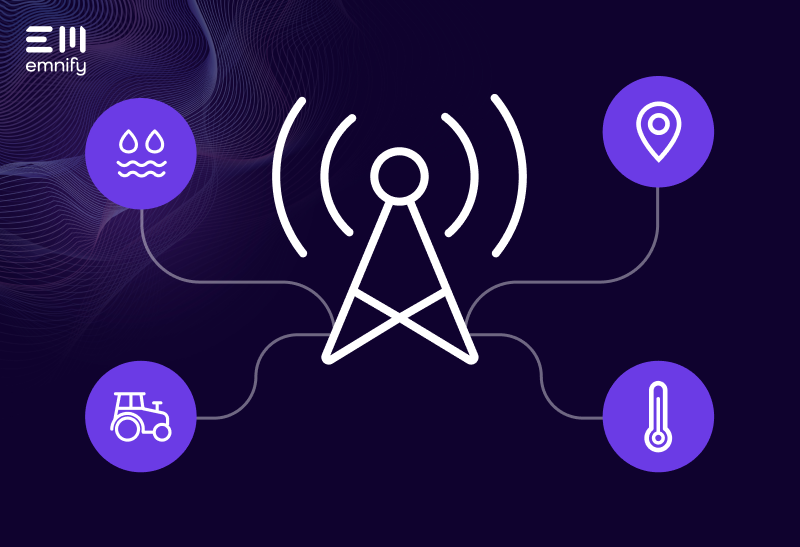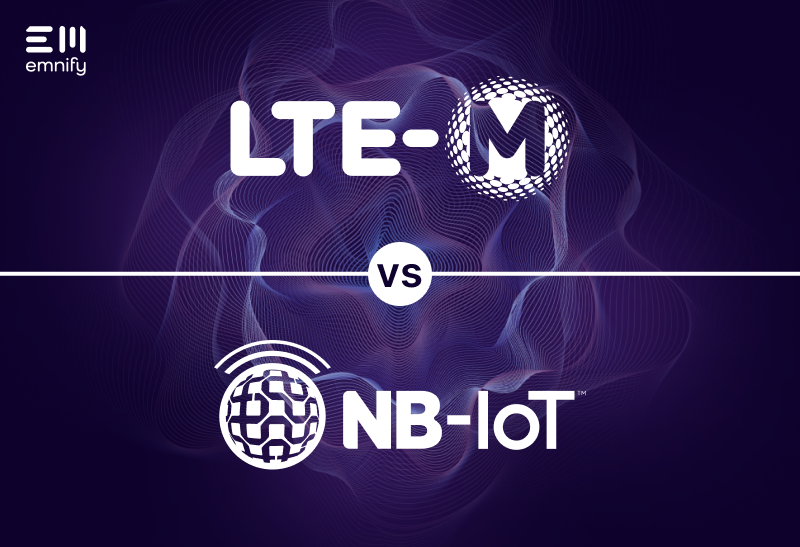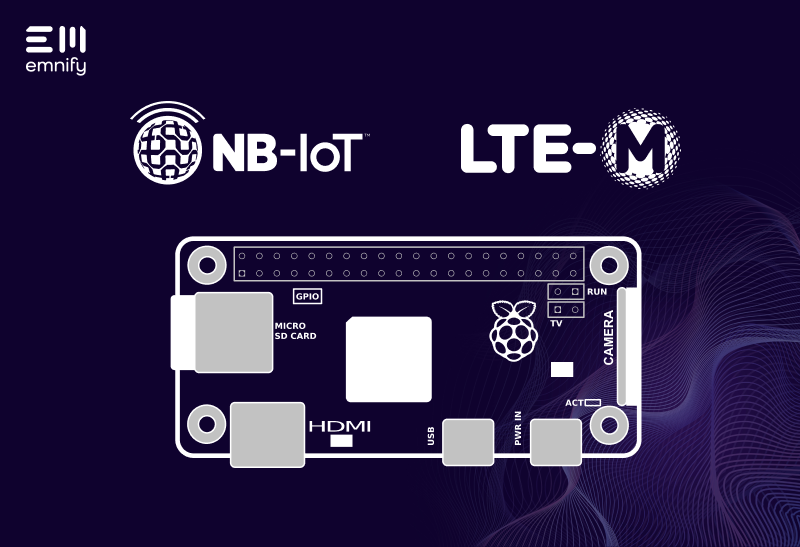

Quick definition: Narrowband IoT, often abbreviated as NB-IoT, is a specialized cellular network made for the Internet of Things.
These Low Power Wide Area Networks (LPWANs) allow a greater volume of devices to share bandwidth than traditional cellular networks like 2G, 3G, and 4G. They enable devices to utilize unused frequencies within a carrier’s licensed bands, and use less power than many other types of network.
As the name implies, NB-IoT networks use narrower frequency band compared to 3G and 4G, while still being a “wide area” network technology. This allows a larger volume of devices to occupy one of the network’s “cells.” Narrowband-IoT networks also enhance coverage by repeating transmissions, improving the receiver’s ability to resolve messages. In theory, this means that they offer greater coverage with less infrastructure than other network types.
In cellular IoT, manufacturers turn to NB-IoT networks because they consume very little power when a device isn’t transmitting. Thanks to power-saving features like Power Saving Mode and Discontinuous Reception (DRX), cellular devices using NB-IoT can have years of battery life.
Here’s what makes NB-IoT useful for IoT applications, as well as some of this technology’s inherent weaknesses.
Advantages of NB-IoT
The biggest reasons to consider NB-IoT connectivity are similar to the reasons manufacturers turn to LTE-M: low power consumption, low interference, and low cost deployments.
Low power consumption
As mentioned above, Narrowband IoT introduced two power-saving technologies that made it more useful for IoT applications than 2G, 3G and 4G networks.
Power Saving Mode (PSM)
PSM allows the device to sleep when not in use, so it isn’t constantly draining the battery. While its predecessors were designed for cell phones, which need to spontaneously connect to each other, NB-IoT and LTE-M was designed for IoT devices, which often connect at predictable intervals and don’t need service in the interim.
Any time a cellular device moves, it sends a Tracking Area Update (TAU) to let the network know where it is. If the device isn’t moving, it sends TAUs periodically to let the network know it is still available. It’s like the device is saying, “I’m still here! Are there any messages for me yet?” This is one of the reasons why cell phones can create spontaneous connections so efficiently. It’s also a significant drain on a cellular device’s battery.
You wouldn’t want a cell phone to go offline when you aren’t using it—because you never know when you’ll receive a call or text (or need to make one). But a smart parking meter? Or a smart HVAC system? When these cellular devices aren’t transmitting, they don’t need to be online and send Tracking Area Updates - because they never expect a downlink message. So they can just change to a Power Save Mode for a longer period of time without exchanging their position with the network.
Extended Discontinuous Reception (eDRX)
Some IoT applications will still want to receive downlink messages - such as configuration change, firmware updates, configuration SMS or remote access. Regular cell phones check the radio in a very short time frame for new messages - and listening to the radio signal consumes power. The period to check for incoming data can be increased to up to 2.56sec by using the Discontinuous Reception mechanism which was already introduced for LTE. For NB-IoT and LTE-M an extended Discontinuous Reception was implemented that allows to extend the period for checking the radio for up to 40 mins.
Efficient spectrum use
Think of every cell of a cellular network as a stadium. When too many devices in the same location share bandwidth, it’s like there aren’t enough seats. The signals interfere with each other.
Since the radio frequency spectrum itself is limited, every country has its own regulating bodies to help ensure the RF spectrum gets used efficiently. They license different frequency bands to different cellular carriers. Each cellular carrier has to decide how to use their bands most effectively.
NB-IoT networks use narrower bandwidths than most other types. It’s like using smaller chairs to fit more people in the stadium. With cell phones, those smaller seats might inhibit a subscriber’s experience on the network, but IoT devices don’t need as much space as a cell phone. Additionally, NB-IoT can use the guard bands—the gaps between networks—which is like putting seats in an aisle.
The Internet of Things will add tens of billions of connected devices in the years to come. Traditional networks simply can’t handle that volume of devices. NB-IoT lets carriers get creative with how they use the RF spectrum, so they can fit more devices in the same cells.
Good indoor coverage
For indoor applications, cellular signals have to penetrate building materials. One of the metrics 3GPP developed to measure a network’s coverage is Maximum Coupling Loss (MCL). It determines how much signal strength can be lost between the transmitter and receiver while still allowing the signal to go through. The theoretic MCL for NB-IoT connections is 164 decibels (dB), which is the highest of any LPWAN.
|
LPWAN Type |
Maximum Coupling Loss (MCL) |
|
NB-IoT |
164 dB |
|
LoRaWAN |
156 dB |
|
Sigfox |
160 dB |
|
LTE-M/Cat-M1 |
156 dB |
That means transmissions sent over NB-IoT networks can penetrate denser building materials (and handle more interference from other signals), making them more useful for devices located indoors in “noisy” indoor environments. Nevertheless for these high MCL numbers NB-IoT requires a lot of retransmission which means that the power consumption is negatively impacted.
Low-cost modems
For IoT manufacturers, connectivity is an important consideration in the Total Cost of Ownership (TCO). The network type you use will impact the cost of every device you produce. In general, more advanced networks with higher data speeds require more complicated (and expensive) modems. Additionally, the countries you deploy to and the carriers you choose often require different modems, so global deployments cost more.
NB-IoT networks have universal modems that work on any NB-IoT network around the world, and they’re much lower cost than 4G LTE or 5G modems.
Note: Despite the modems being low cost, it’s worth considering that NB-IoT devices need a chipset that supports legacy technologies. When NB-IoT connectivity isn’t available, these networks fall back on 2G service. Incorporating chips that support outdated technology can increase your costs.
Disadvantages of NB-IoT
For all its strengths, NB-IoT has its weaknesses, too—especially in comparison to LTE-M. Here are a few things to consider before going all-in with Narrowband IoT connectivity.
Low data speeds
While NB-IoT works well in both outdoor and indoor environments and can provide adequate coverage, it’s simply not an option for applications with greater data needs. Whether your device needs to download or upload data, your max data speed is just a fraction of a megabit. And when most network types measure latency (the time it takes the transmission to travel across the network) in milliseconds, the latency for NB-IoT can be up to 10 seconds. That’s not viable in settings where delays can cost your customers dearly.
In applications that need to transmit large volumes of data per data session, NB-IoT becomes less power efficient, too. Between the extended latency and low uplink/downlink speeds, NB-IoT forces applications to stay online longer and use more power to transmit than other solutions like LTE-M. As a rule of thumb, if your device needs to send multiple KBs per data session, LTE-M will be better. If your data packets remain within the bytes scale, then NB-IoT is a good option for your project.
Multiple providers required for global deployment
Most cellular carriers don’t have established roaming agreements for their NB-IoT networks. This means that your contract with a provider often only covers the specific region they serve. If you want to deploy to another country or region, you’ll likely need an additional contract with another provider—every time.
Don’t want bills coming from MNOs all around the world? Don’t use NB-IoT for global deployments.
No redundant coverage
Network redundancy is crucial for keeping your devices continually connected and minimizing the impact of disasters, errors, and other outages. If your Narrowband IoT network goes down for any reason or your device simply enters an area with poor coverage, there’s no backup system in place to take over. There’s no alternative network to select.
This is why many carriers rely on legacy networks to provide coverage in areas where NB-IoT is unavailable. But that means you and your customers can’t expect consistent costs or power consumption. So depending on where you deploy and what provider is available in the region, it may be hard to predict what kind of service you can expect. On top of that, these legacy networks are being sunset, so they can’t be relied upon moving forward.
Lack of handover support
In mobile use cases, IoT devices will often move from cell to cell within a network. As they move across cell borders, network resources like eNBs anticipate and facilitate the transition.
But while NB-IoT can keep devices connected while they’re moving, this technology doesn’t support handovers. This means while the device moves away from the antenna it increases its transmit power until the connection fails - and only then builds up a connection to the new cell. This makes them poor solutions for mobile use cases like fleet tracking systems and asset tracking devices as the increased power transmission and reconnection to the next cells consumes more battery.
Choose the network that’s right for your application
Your connectivity plan has a significant impact on your device’s capabilities, performance, and life span. If you want to deploy your devices globally, you may need to consider a more versatile solution than Narrowband IoT.
Want to learn more about how emnify's IoT connectivity solution?
Get in touch with our IoT experts
Discover how emnify can help you grow your business and talk to one of our IoT consultants today!

Nhu has over six years of experience working with networking technologies and IoT connectivity solutions. She’s an avid tech learner with a customer-focused mindset.


